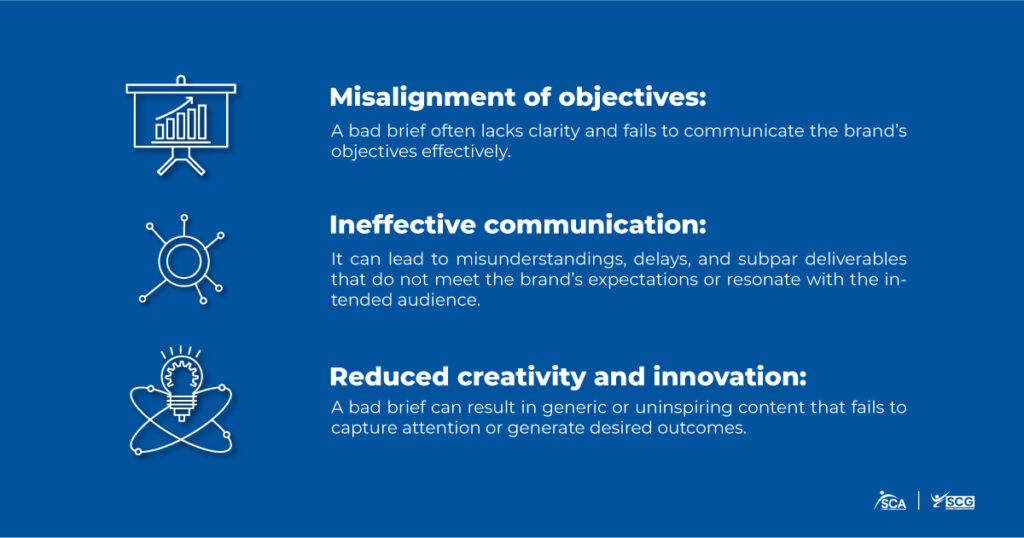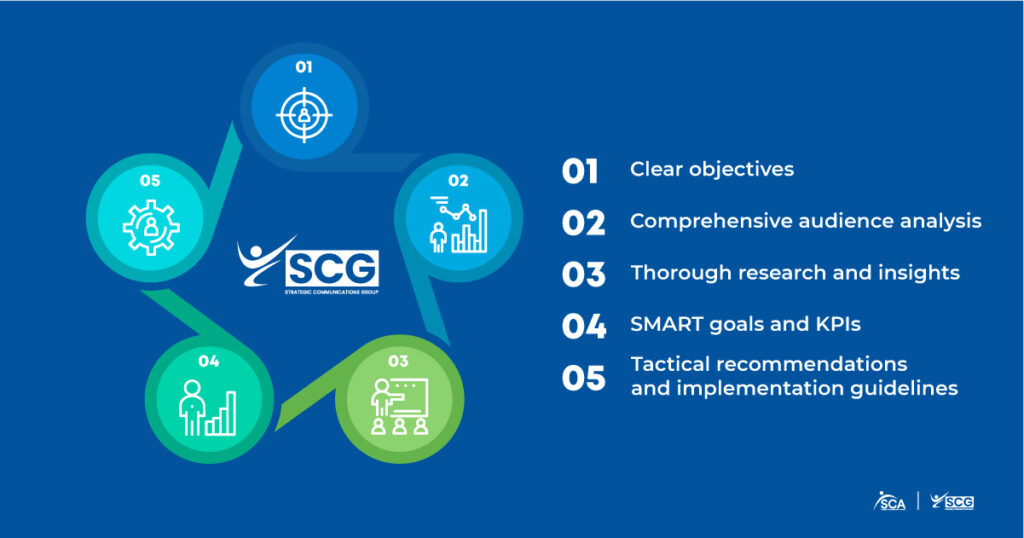A bad brief can lead to misalignments. This can show up as a misalignment of objectives, creating a disconnect between you and your team, or your agency/consultancy.
The lack of clarity hinders strategic planning and undermines the ability to achieve desired outcomes.
A poor brief can waste resources.
It sends your team down the wrong path, one that they have to backtrack on and start from the beginning again. This results in inefficient utilisation of time, budget, and talents, leading to missed deadlines, increased costs, and the need for revisions or rework.
On the other hand, a good brief – in our discipline – can be like a breath of fresh air after having spent too much time breathing in the haze surrounding us.
The consequences of giving bad briefs
Bad briefs are typically a result of ineffective communication.
Insufficient information in the brief can cause misunderstandings and delays, impacting the quality of deliverables and one reason for failing to resonate with the target audience.
It can restrict creativity and innovation by providing limited inspiration, insights, or creative freedom. This reduces the ability to develop unique and compelling PR strategies, resulting in generic or uninspiring content.
A bad brief can strain relationships between the client, internal teams, and external agencies/consultants, leading to a breakdown in trust and collaboration, which can have long-term consequences for future campaigns and partnerships.
Let’s explore in more detail several consequences of a bad brief:
- Misalignment of objectives: A bad brief often lacks clarity and fails to communicate the brand’s objectives effectively. This can result in a misalignment of expectations between you and your team/agency/consultancy. When the objectives are not well-defined, it becomes challenging to develop a strategic approach, and it hampers the team’s ability to deliver desired outcomes.
- Ineffective communication: A bad brief often lacks essential information, such as target audience, key messaging, or desired outcomes. This incomplete or insufficient information hampers effective communication between you and your team/agency/consultancy. It can lead to misunderstandings, delays, and subpar deliverables that do not meet the brand’s expectations or resonate with the intended audience.
- Reduced creativity and innovation: A poorly crafted brief limits the creative and innovative potential of the PR team and external agencies. When a brief lacks inspiration, fails to provide insights, or restricts creative freedom, it stifles the ability to develop unique and compelling PR strategies and campaigns. This can result in generic or uninspiring content that fails to capture attention or generate desired outcomes.

What if it was possible to prepare good briefs…every time?
Based on experience, it is possible to consistently craft good briefs with proper planning and communication. This requires a systematic approach and adherence to best practices when putting a brief together.
The emphasis here is on ‘every time’ and consistency.
Adopting a systematic approach in crafting briefs helps ensure consistency, efficiency, and effectiveness.
It involves implementing structured processes and guidelines to enhance the quality of brief.
This approach involves implementing brief templates that include key sections such as objectives, target audience, key messages, and desired outcomes. It also emphasises the importance of briefing meetings or workshops to gather information, thorough research and data gathering, and establishing review and approval processes. Proper documentation, version control, and a feedback loop for evaluation are crucial elements as well.
The goal is to ensure briefs are consistently developed with clarity, comprehensiveness, and alignment with strategic goals. The approach enhances communication, streamlines processes, and minimizes misinterpretation or ambiguity. It also facilitates collaboration between you and your team/agency/consultancy while encouraging efficient resource utilization.
Here are the first 2 steps in putting together a good brief for your organisation.
Out of all the areas and information that you can include in a brief, here are the first 2 steps that you should not skip or miss out on.
If the information is not available, take a step back and confer with stakeholders repeatedly until the information is sufficient.
Without these key points, continuing the rest of the brief will only be a waste of time.
Clear objectives: This step sets the foundation for success by providing a clear direction for the entire campaign.
- Clearly define the objectives of the campaign in the brief.
- These objectives should be specific, measurable, achievable, relevant, and time-bound (SMART).
- Clearly outlining the desired outcomes helps align all stakeholders and guides the PR team or agency in developing a strategic plan to achieve those objectives.
- Ensure that details involving what, why, who, how, and when are present.
- Avoid acronyms, jargon, and lingo.
- Keep it simple.
Comprehensive audience analysis: By including a comprehensive audience analysis, the brief ensures that the PR efforts are precisely targeted and have a higher likelihood of success.
- Conduct a thorough analysis of the target audience and include the findings in the brief.
- This analysis should go beyond demographic information and delve into psychographics, behaviors, preferences, and media consumption habits of the audience.
- Understanding the target audience helps tailor the messaging, tone, and channels used in the PR campaign to effectively engage and resonate with them.
- Knowing and understanding the audience can contribute to making the narrative, positioning, messaging and content engaging, relevant, clear, and factual.
Including these two steps in a good brief sets the stage for a focused and effective communications/PR campaign.
Sidebar: The compounding effects of giving good briefs.
The point of giving a good brief is not just about enjoying the good outcome that happens for your programme or campaign.
Consistency will lead to compound effects, especially when it is supported by a a long-term mindset that focuses on sustainable growth, positive feedback loops, competitive advantage, and personal career development.
This perspective allows you to leverage the cumulative impact of consistently delivering high-quality briefs, which can ultimately lead to greater organisation/brand success and professional fulfillment.
By considering the compounding perspective, you can shift your focus beyond individual projects or immediate outcomes and look at the broader picture of growth, reputation, and sustained success.
Here are some of the long-term benefits and cumulative impact that consistently providing high-quality briefs can have on programmes/campaigns and the overall success of you and your team:
- Sustainable growth: The compounding perspective acknowledges that the impact of good briefs can extend far beyond a single campaign. By consistently delivering effective briefs, you can build a strong reputation for delivering quality work, attracting new clients, and fostering long-term partnerships. This sustainable growth leads to a steady increase in opportunities, revenue, and professional development.
- Positive feedback loop: By recognizing the compounding effects of good briefs, you can create a positive feedback loop. Each successful campaign driven by a good brief enhances your credibility, expertise, and stakeholder satisfaction. This, in turn, strengthens your ability to secure more impactful projects, work on key/critical programmes, and attract top talent. The compounding effects generate a virtuous cycle of continuous improvement and success.
- Competitive advantage: Considering the compounding perspective gives you an edge over your competitors. When you consistently provide good briefs that result in successful campaigns and satisfied stakeholders, you establish themselves as a reliable and effective professional in the industry. This reputation becomes a competitive advantage, leading to more opportunities and referrals, and positioning you as a trusted authority in your industry and discipline.
- Professional development: The compounding perspective encourages you to continuously improve their skills, knowledge, and processes. By reflecting on past briefs and campaigns, seeking feedback, and implementing lessons learned, you can refine your approach, stay ahead of industry trends, and adapt to evolving stakeholder needs.
Here are 3 more steps to insert into your brief preparation workflow.

In addition to the earlier 2 steps shared, you can tap on these 3 more steps to further improve your preparation workflow.
Thorough research and insights:
- Conduct extensive research to gather relevant information and insights that inform the brief.
- This includes analysis on your brand, industry trends, and competitor landscape.
- Incorporate key findings into the brief to ensure a solid foundation for strategic decision-making and message development.
SMART goals and KPIs:
- Define specific, measurable, achievable, relevant, and time-bound (SMART) goals in the brief.
- Establish clear KPIs that will be used to assess the success of the campaign.
- This step ensures that the objectives are well-defined, allows for effective evaluation, and enables the team to track progress and demonstrate the impact of efforts.
Tactical recommendations and implementation guidelines:
- Provide tactical recommendations and implementation guidelines in the brief.
- This includes outlining the recommended strategies, channels, tactics, and key milestones.
- Incorporate a timeline that maps out the various activities and deadlines to ensure efficient project management.
- Clearly communicate roles and responsibilities, ensuring that everyone involved understands their contributions to the campaign’s success.
One additional recommendation is to engage your team and agency/consultancy in a collaborative brainstorm session. The combined team – through open dialogue, active participation, and a non-judgmental atmosphere – can help shortcut the concept process by generating ideas for the programme and campaign. It also encourages ownership within the team as it is a shared idea and not one forced upon any party.
By incorporating these additional steps into the workflow, you and your team can further enhance the quality and effectiveness of your briefs. Together, these steps can contribute to consistently creating good briefs that drive impactful campaigns.
I provide communications and PR solutions for organisations and communicators through counsel, consultancy, training and solutions. With over 20+ years in the industry, we have created frameworks, methods and content that enable you and your team to launch, grow, level up and earn revenue effectively and efficiently.
Here are 3 ways I can help communications, marketing and PR practitioners:
- Consultancy and enablement: My team can support brands, consultancies and agencies with a plug-and-play strategy and execution solution that delivers business outcomes relating to revenue, entry, scale, and expansion.
- Training and Workshops: We train communicators using a hybrid system of in-person training and a cloud-based learning management platform. Training is done on topics such as project management, stakeholder management and on PR skills such as writing, creating and measuring outcomes, campaign execution, media relations, issues management, and crisis communications. We focus on levelling up communicators’ skill sets, competencies, and personal development by taking their craft to the next level.
- Solutions:
- We match brands and agencies/consultants/contractors by acting as a middleman, helping clients find suitable products, services, or opportunities based on their specific needs relating to PR, communications and marketing services and outcomes.
- My team builds custom LMS solutions for your learners, providing an interactive platform and adapting your organisation’s specific methodologies into the learning content.
Set up a meeting with me with me if you are looking for to deliver growth outcomes for your organisation, brand/s and team/s:
And subscribe to join over 1,500+ communicators and brands getting value every Tuesday while reading A Communicator’s Perspective, our weekly newsletter.